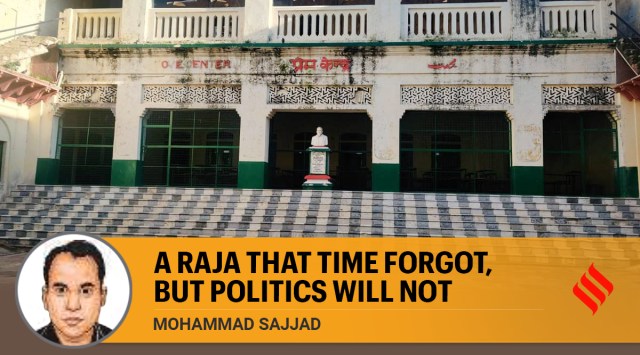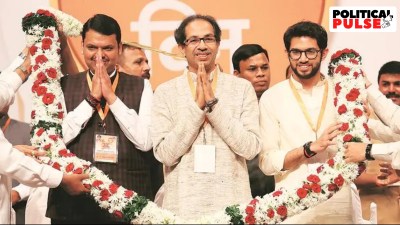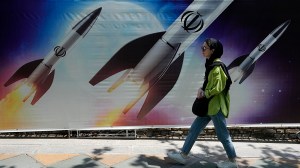- India
- International
A Raja that time forgot, but politics will not
Mohammad Sajjad writes: The interest is least because of what Mahendra Pratap stood for, and more, it seems, for political gains! For, the Raja was a very unusual freedom fighter.
 Raja Mahendra Pratap’s bust at Prem Mahavidyalaya (one of India’s first polytechnics) that he founded. (Avishek G Dastidar)
Raja Mahendra Pratap’s bust at Prem Mahavidyalaya (one of India’s first polytechnics) that he founded. (Avishek G Dastidar)Written by Mohammad Sajjad
“All religions arare a set of ideas given to the human race in the interest of human well-being. (There has to be) unity of religions. They differ only because they were produced at different times and different space… Governments of today are the worst disturbers of peace.”
So say the prefatory notes in My Life Story of Fifty Five Years — a memoir by Raja Mahendra Pratap (1886-1979), the Jat Raja of Mursan, Hathras.
In recent times, there has been renewed interest in the Raja. Last week, Prime Minister Narendra Modi laid the foundation stone for a state university named after him. The interest is least because of what Mahendra Pratap stood for, and more, it seems, for political gains! For, the Raja was a very unusual freedom fighter.
The third son of the Raja of Mursan, he was adopted by the Raja of Hathras, and married to the Princess of Jind, while studying at MAO College, Aligarh. The founder of MAO College, Sir Syed, and Mahendra Pratap’s father Raja Ghanshyam were close. In 1920, MAO College (Mohammedan Anglo-Oriental College) was upgraded to Aligarh Muslim University. One of the BJP’s demands ironically has been that AMU be named after Mahendra Pratap.

It was during the time he was at MAO College, in the first decade of the 20th century, that the campus saw growing restiveness against the British. It started when Justice Syed Mahmood, son of Sir Syed, was removed as secretary of the college in 1899, apparently at the behest of British loyalists.
In 1903, Hasrat Mohani, a student who had launched the fiercely anti-colonial periodical Urdu-e-Mualla, was imprisoned. In 1905, students from the college attended the Congress’s Benaras session, presided over by Gopal Krishna Gokhale. A year later, the Aligarh Student Union passed a resolution advocating Hindu-Muslim political cooperation to expel the British. In 1907, there was a massive student strike led by, among others, Syed Mahmud (who later served in Jawaharlal Nehru’s cabinet). As the students started putting up portraits of Gokhale, German Emperor Wilhelm II and leaders of the Ottoman Empire in their hostel rooms, the British kept an anxious watch.
Mahendra Pratap was among the students who wanted to change the system, but he differed from others in taking India’s freedom struggle global during 1915-1945 — travelling the world, delivering talks, writing columns and mobilising funds.
He also wrote to Gokhale seeking to go to South Africa to join Mahatma Gandhi, who had launched a Satyagraha there, but was dissuaded by the Congress leader. The Raja then offered Rs 1,000 (then a royal sum) for the cause. In 1906, he attended the Congress session at Calcutta, against the wishes of his father-in-law, the ruler of Jind, who apprehended British wrath. In 1910, Mahendra Pratap was part of the reception committee of the Allahabad session of the Congress. In his memoir, he talks about proposing a “religion of love”, and accordingly founded Prem Mahavidyalaya or Free Industrial & Arts National College (one of India’s first polytechnics), at Mathura.
In personal life too, the Raja broke barriers by eating with a sweeper at Agra. He launched periodicals such as Prem and Nirbal Sewak. He also joined hands with the Ghadar revolutionaries, based abroad, who supported a mutiny in the British Army.
 As a need was felt to raise the Indian demand on a global scale, on December 1, 1915, his birthday, the Raja announced a provisional Indian government-in-exile in Kabul. He was the President and fellow revolutionary Maulana Barkatullah the Prime Minister. This came to be known as the ‘Silk Letter Conspiracy’.
As a need was felt to raise the Indian demand on a global scale, on December 1, 1915, his birthday, the Raja announced a provisional Indian government-in-exile in Kabul. He was the President and fellow revolutionary Maulana Barkatullah the Prime Minister. This came to be known as the ‘Silk Letter Conspiracy’.
His plan was to form “an international socialist army for India’s freedom”. He set up offices in Germany, and in Japan, met Rash Behari Bose and raised funds for him, particularly from Afghanistan and Turkey.
The Raja also became friends with rulers such as the Afghan king Amanullah, whom he admired for modernising his country. He notes that he observed Buddha Jayanti there, and that despite Ramzan fasting, many Afghan Muslims turned up (a past that the Bamiyan vandals chose to forget).
After the Bolshevik Revolution, he writes about having met Lenin, as part of “a plan to surround India with anti-British empire and pro-India states”. He said Germany in the West and Japan in the East were destroying the British, and hence the only challenge before the Indians was to minimise the gap between the rich and poor and Hindus and Muslims, to gain freedom.
He also advocated an ‘Aryan Federation’ within the Congress — proposing an all-India language with Roman characters, borrowing simple words from the various dialects, for linguistic uniformity. Aryans, he said, shared cultures from Iran to Assam, and this was a step towards world unity.
“I want to free England, India, Germany, Japan from their war-lords,” he said, saying Hitler, Mussolini, militarist Japan were all welcome. “Why should I condemn those whose mutual conflicts are basically hitting at empires.”
Impressed, the Mathura district unit of the Congress proposed to name the township of the provincial Congress session in his name, and to erect a life-size statue of the Raja.
The Raja is said to have been glad, but disapproved of a statue.
The writer is professor at AMU and specialises in modern Indian history
EXPRESS OPINION
More Explained
Apr 20: Latest News
- 01
- 02
- 03
- 04
- 05









































